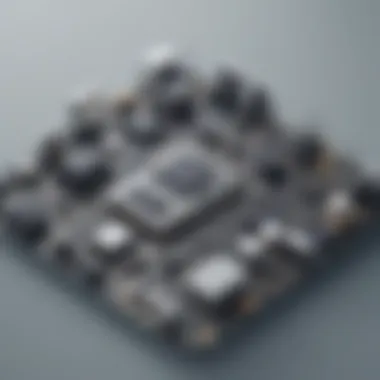Unveiling the Progression of IoT Devices in the Year 2021


Technological Research Overview
In delving into the evolution of Io T devices in 2021, it becomes imperative to first examine the recent technological innovations that have catalyzed this expansion. From advancements in connectivity protocols to the miniaturization of sensors, the landscape of IoT devices is constantly in a state of flux, driving unprecedented progress and reshaping industries. This section will explore how these innovations impact business operations, offering a lens through which to understand the significance of IoT devices in enhancing efficiency and productivity. Moreover, insights into future technological trends will be elucidated, providing a glimpse into what lies ahead for IoT in 2021 and beyond.
Data Analytics in Business
As Io T devices continue to proliferate, the importance of data analytics in harnessing the potential of these devices cannot be overstated. This section will delve into the tools and techniques used for data analysis in the context of IoT, shedding light on how businesses can extract meaningful insights from the vast amounts of data generated by connected devices. Case studies will be utilized to illustrate real-world examples of data-driven decisions, showcasing the transformative power of analytics in driving strategic business outcomes.
Cybersecurity Insights
Amidst the rapid growth of Io T devices, cybersecurity emerges as a critical concern that organizations must address to mitigate risks and safeguard sensitive data. This section will provide a detailed analysis of the threat landscape facing IoT ecosystems, exploring the vulnerabilities that malicious actors exploit. Best practices for cybersecurity in the IoT realm will be outlined, emphasizing the importance of proactive measures and robust security protocols. Furthermore, the discussion will touch upon regulatory compliance requirements that shape cybersecurity frameworks, ensuring that organizations are aligned with industry standards and mandates.
Artificial Intelligence Applications
Artificial intelligence (AI) plays a pivotal role in optimizing business processes and unlocking new opportunities in the realm of Io T devices. This section will delve into the integration of AI technologies for business automation, showcasing how machine learning algorithms enhance operational efficiency and decision-making. Moreover, the applications of AI in diverse domains, from predictive maintenance to anomaly detection, will be explored to illustrate the versatility of AI in driving innovation. Ethical considerations surrounding AI implementation in IoT devices will also be addressed, highlighting the importance of responsible AI usage in upholding ethical standards.
Industry-Specific Research
The evolution of Io T devices has catalyzed transformative changes across various industries, with distinct impacts observed in sectors such as finance, healthcare, and retail. This section will provide insights into the technological research conducted in the finance sector, uncovering how IoT devices are revolutionizing transaction processing, risk management, and customer engagement. Healthcare technological advancements driven by IoT devices will also be examined, showcasing how remote monitoring, personalized care, and predictive analytics are reshaping the healthcare landscape. Furthermore, the adoption of IoT solutions in the retail industry will be explored, demonstrating how smart inventory management, personalized shopping experiences, and data-driven insights are driving revenue growth and enhancing customer satisfaction.
Introduction to IoT Devices
In the realm of Io T devices in 2021, understanding their significance is paramount. IoT devices, or Internet of Things devices, represent a network of interconnected smart gadgets that communicate and share data for various applications. These devices play a pivotal role in revolutionizing how we interact with technology on a daily basis, from smart homes to complex industrial systems. Their ability to gather and analyze data in real-time opens up a realm of possibilities for innovation and efficiency across sectors. This article aims to delve into the diverse landscape of IoT devices in 2021, showcasing their impact and evolution throughout the year.
Definition of IoT Devices
Understanding the concept of Io
T Delving into the concept of Io T unveils a world where devices communicate seamlessly to enhance our productivity and convenience. IoT revolves around the idea of interconnectivity, where everyday objects are embedded with sensors and software to collect, analyze, and exchange data autonomously. This interconnected web of devices allows for automation, smart decision-making, and optimized processes in various domains. The concept of IoT paves the way for a more interconnected and intelligent future, where data fuels innovation and efficiency.
Exploring the role of connected devices


The role of connected devices in Io T ecosystems is crucial for seamless communication and data exchange. These devices form the backbone of IoT networks, facilitating the transmission of information between different endpoints. By enabling seamless connectivity and data flow, connected devices ensure that IoT systems function harmoniously to deliver real-time insights and drive operational efficiencies. Despite their instrumental role, challenges such as data security and compatibility issues pose potential drawbacks that must be addressed systematically.
Importance of IoT Devices
Enhancing efficiency and productivity
Io T devices are instrumental in enhancing operational efficiency and productivity across industries. By streamlining processes, automating tasks, and providing real-time insights, these devices enable organizations to optimize their operations and allocate resources efficiently. The integration of IoT devices leads to enhanced performance metrics, reduced downtimes, and improved overall productivity, setting the stage for a more agile and productive workforce.
Enabling data-driven decision-making
One of the key benefits of Io T devices lies in their ability to enable data-driven decision-making. By continuously collecting and analyzing data from various sources, these devices provide organizations with valuable insights for informed decision-making. With data guiding strategic choices, businesses can adapt to market trends, anticipate customer needs, and stay ahead of the curve. However, ensuring data accuracy, integrity, and privacy is crucial to harness the full potential of data-driven decision-making in the IoT ecosystem.
Statistics and Numbers
In the realm of Io T devices, statistics and numbers play a pivotal role in offering insights into the trends, growth, and adoption rates within the industry. By delving into the statistical data and numerical figures associated with IoT devices, stakeholders can glean valuable information that aids in decision-making processes, strategic planning, and market analysis. Understanding the significance of statistics and numbers provides a solid foundation for evaluating the impact and scalability of IoT technologies across various sectors.
Global IoT Device Adoption
Trends in Io
T adoption worldwide
The global landscape of Io T adoption is witnessing a remarkable surge, with trends indicating a substantial increase in the integration of connected devices across industries and consumer households. One key characteristic of trends in IoT adoption is the exponential growth in smart technologies interfacing with daily activities, revolutionizing how individuals interact with their environments. This trend has become a popular choice for companies seeking to enhance operational efficiencies and customer experiences through seamless connectivity and data utilization. Moreover, the unique feature of trends in IoT adoption lies in their ability to catalyze innovations and disrupt conventional business models, presenting both advantages and disadvantages in terms of scalability, security, and regulatory compliance within the IoT ecosystem.
Number of Io
T devices in use
The escalating number of Io T devices in use underscores the magnitude of interconnected technologies infiltrating our modern world. This proliferation contributes significantly to the overall expansion and diversification of the IoT landscape, indicating a growing reliance on smart devices to streamline processes and enable data-driven decision-making. The key characteristic of the increasing number of IoT devices lies in the seamless connectivity they offer, facilitating real-time data transmission and analysis for improved functionality and user convenience. This surge represents a beneficial choice for this article as it underscores the widespread embrace of IoT solutions across varying sectors, though not without challenges such as data privacy concerns, device interoperability issues, and cybersecurity vulnerabilities.
IoT Device Market Growth
Revenue projections for Io


T devices
Forecasting revenue projections for Io T devices is instrumental in gauging the economic potential and market viability of IoT technologies in the coming years. By analyzing revenue forecasts, industry experts and investors can anticipate growth opportunities, investment trends, and consumer demand for IoT solutions. The key characteristic of revenue projections lies in providing actionable insights for businesses looking to capitalize on the expanding IoT market through product development, marketing strategies, and competitive positioning. This aspect is a popular choice for this article as it underscores the financial aspect of IoT adoption and its implications for revenue generation, market competitiveness, and industry sustainability. However, revenue projections also come with challenges such as market volatility, fluctuating consumer preferences, and regulatory uncertainties that may impact investment decisions and business profitability.
Market share of key players
The distribution of market share among key players in the Io T industry reflects the competitive dynamics and market dominance of leading technological innovators. Analyzing the market share of key players enables industry observers to assess the strategic positioning, product portfolios, and global influence of major IoT providers. The key characteristic of market share allocation lies in identifying market leaders, emerging disruptors, and niche players shaping the IoT ecosystem's trajectory. This analysis is a beneficial choice for this article as it elucidates the power dynamics, collaboration opportunities, and future trends within the competitive IoT landscape. Nevertheless, understanding market share entails considerations of brand reputation, technological differentiation, and customer loyalty, which can impact market sustainability and growth strategies.
Io
T Devices in Different Sectors
Healthcare IoT devices
The integration of Io T devices within the healthcare sector is revolutionizing patient care, medical diagnostics, and health management practices. Healthcare IoT devices offer a distinct advantage by facilitating remote monitoring, personalized treatment plans, and data-driven healthcare decisions that enhance patient outcomes and operational efficiencies. The key characteristic of healthcare IoT devices is their role in promoting preventive care, early intervention, and treatment optimization through continuous data tracking and analysis. This spotlight on healthcare IoT devices is a beneficial choice for this article as it underscores the transformative impact of IoT technologies on the health industry, though challenges such as data security, regulatory compliance, and interoperability standards must be addressed to ensure patient privacy and system integrity.
Smart cities and Io
T integration
The synergy between smart cities and Io T integration presents a promising landscape of urban development, sustainability initiatives, and enhanced quality of life for residents. By embedding IoT technologies into urban infrastructures, cities can optimize resource utilization, improve public services, and foster environmental sustainability through data-driven decision-making. The key characteristic of smart cities and IoT integration lies in the interconnectedness of sensors, devices, and data networks that create a resilient and responsive urban ecosystem. This integration is a favorable choice for this article as it showcases the convergence of technology, governance, and community engagement in building smarter and more interconnected urban environments. However, challenges such as privacy concerns, data governance, and digital divide issues must be navigated to ensure equitable access to smart city solutions and address socio-economic disparities.
Technological Innovations
In delving into the landscape of Io T devices in 2021, it is imperative to understand the pivotal role of technological innovations. The continuous evolution of technology drives the progress and efficacy of IoT devices, impacting their applications across various sectors. Technological advancements play a critical role in enhancing the functionalities and capabilities of IoT devices, leading to increased efficiency and performance.
Advancements in Io
T Technology
Integration of AI and machine learning
The integration of artificial intelligence (AI) and machine learning stands out as a cornerstone in the realm of Io T technology. This fusion empowers IoT devices with the ability to analyze vast amounts of data in real-time, enabling them to make intelligent decisions and adapt to changing environments seamlessly. The key characteristic of this integration lies in the autonomy it provides to IoT devices, allowing them to learn from experiences and optimize their operations without human intervention. This sophisticated feature significantly contributes to the overall performance and efficiency of IoT devices, making them a popular choice for diverse applications. However, the reliance on AI and machine learning introduces complexities in data processing and security, necessitating robust measures to safeguard against potential threats.


Edge computing in Io
T devices Another pivotal aspect of Io T technology is edge computing, a decentralized computing paradigm that brings computation and data storage closer to the devices where it's needed. By processing data locally at the edge of the network, IoT devices reduce latency, enhance responsiveness, and minimize bandwidth usage. This key characteristic of edge computing ensures faster decision-making and optimized resource utilization within IoT ecosystems, making it a beneficial choice for real-time applications. The unique feature of edge computing lies in its ability to address the limitations of cloud computing, offering advantages like improved efficiency, reduced operational costs, and greater autonomy to IoT devices. However, despite these benefits, edge computing also poses challenges related to security vulnerabilities and governance, requiring a careful balance between decentralized processing and centralized control.
Security Challenges and Solutions
Data privacy concerns
Data privacy emerges as a critical concern in the context of Io T devices, as the collection and analysis of personal data raise ethical and regulatory issues. Ensuring the confidentiality and integrity of user information poses a significant challenge for IoT networks, necessitating transparent policies and robust data protection mechanisms. The key characteristic of data privacy concerns lies in the need for stringent data governance frameworks and encryption protocols to safeguard sensitive information against unauthorized access. While data privacy is a popular focus area for regulatory bodies and industry standards, the inherent complexities of IoT ecosystems demand continuous vigilance and compliance to mitigate privacy risks.
Implementing robust cybersecurity measures
To mitigate the evolving threat landscape in Io T environments, implementing robust cybersecurity measures is paramount. Proactive strategies such as network segmentation, encryption algorithms, and intrusion detection systems play a crucial role in fortifying IoT devices against cyber attacks. The key characteristic of cybersecurity measures involves a multi-layered approach that combines preventive, detective, and responsive controls to mitigate vulnerabilities and safeguard data integrity. By adopting comprehensive security protocols and threat intelligence mechanisms, organizations can uphold the confidentiality and availability of IoT systems while minimizing the risk of cyber incidents. However, the intricate nature of cybersecurity implementations requires continual evaluation and adaptation to counter emerging threats and ensure the resilience of IoT infrastructures.
Future Outlook
The section on Future Outlook in the context of Io T devices in 2021 is crucial for understanding the trajectory of technology. It sheds light on the upcoming trends, challenges, and advancements that will shape the industry in the coming years. By analyzing the future outlook, stakeholders can make informed decisions and strategize effectively. This section offers insights into the potential growth areas, emerging technologies, and the impact of IoT on various sectors.
Emerging Trends in Io
T Devices
5G impact on Io
T ecosystem The 5G impact on the Io T ecosystem is a pivotal aspect influencing the connectivity and performance of IoT devices. With its ultra-fast speeds and reduced latency, 5G is revolutionizing the way IoT devices communicate and function. Its ability to handle massive data loads efficiently makes it an attractive choice for IoT applications requiring real-time data processing. However, challenges like infrastructure readiness and security concerns need to be addressed for optimal implementation.
IoT wearable devices
Io T wearable devices have gained momentum in the IoT landscape, offering personalized connectivity and data tracking for users. These devices integrate seamlessly into everyday life, providing valuable insights into health, fitness, and productivity. The key characteristic of IoT wearables lies in their ability to collect and analyze data in real-time, offering users actionable information for improved decision-making. While their convenience and functionality are undeniable, issues related to data privacy and security remain pressing concerns.
Predictions for and Beyond
Io
T device connectivity advancements The advancements in Io T device connectivity are poised to revolutionize the way devices interact and communicate within the ecosystem. With technologies like Bluetooth Mesh and LPWAN gaining prominence, IoT devices can now connect over long distances with minimal power consumption. The key characteristic of these advancements is their ability to create a seamless network of interconnected devices, enhancing operational efficiency and user experience. Despite their benefits, interoperability challenges and standardization issues need to be navigated for widespread adoption.
Role of Io
T in sustainability The role of Io T in sustainability underscores the potential of technology to drive environmental conservation and resource efficiency. By enabling smart energy management, waste reduction, and emission monitoring, IoT devices play a vital role in promoting sustainable practices across industries. The key characteristic of IoT in sustainability is its ability to optimize resource usage and enhance eco-friendly initiatives. However, concerns regarding electronic waste management and carbon footprints require holistic solutions to maximize the environmental impact of IoT implementations.







